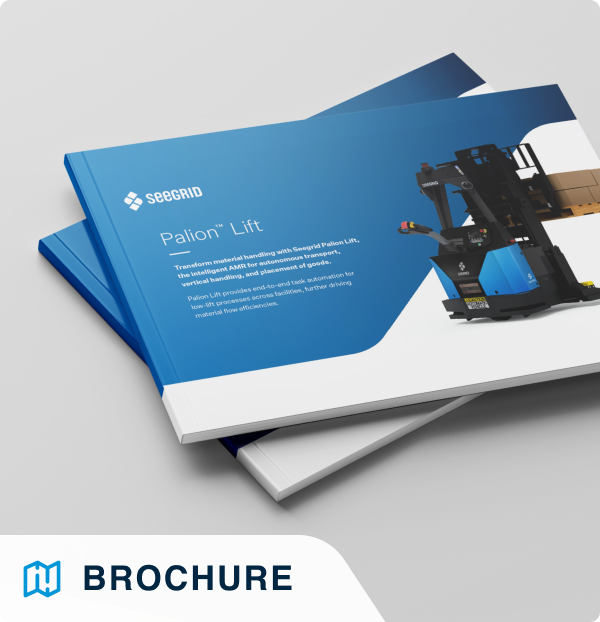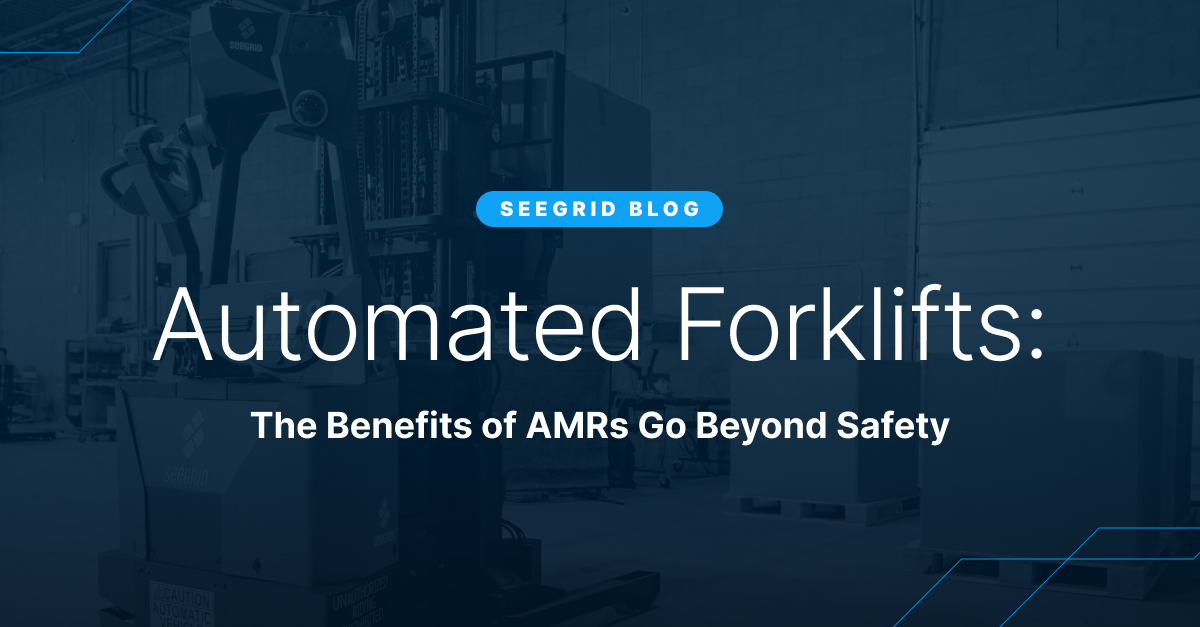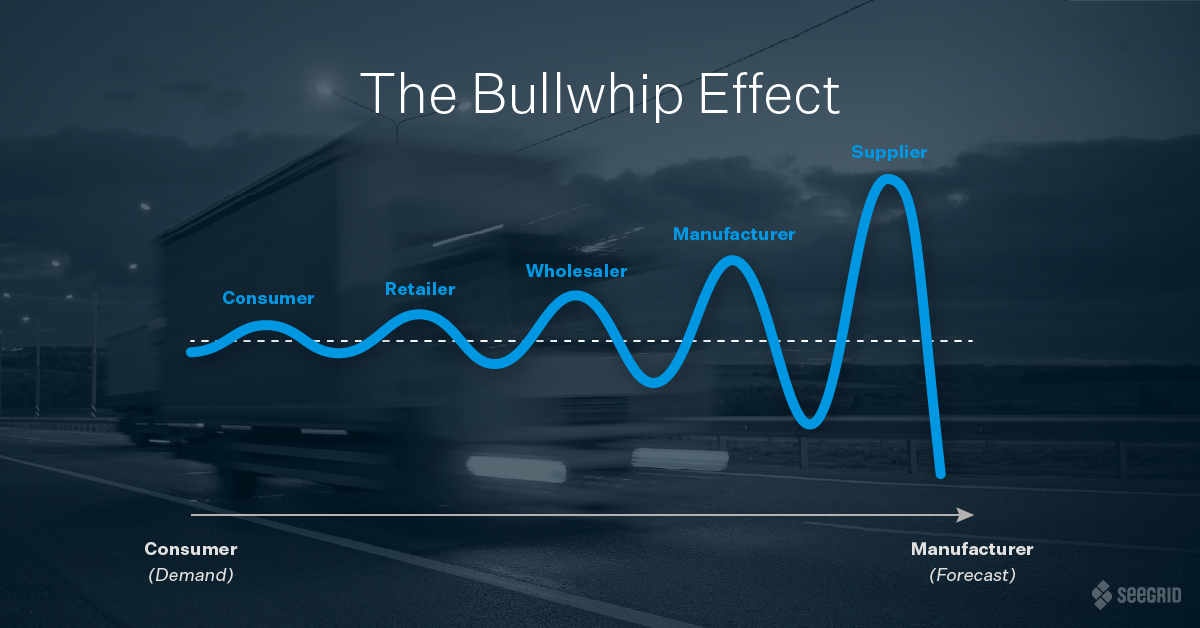In the final segment of this two-part blog series on safety driving automation initiatives, we uncover the consequential costs associated with manual forklift operator labor and the benefits resulting from implementing driverless autonomous mobile robots (AMRs), like Seegrid Palion™ Lift, to facilitate a lean and flexible material handling process.
 |
Brochure: Seegrid Palion Lift AMRDownload the brochure to learn how to transform your material handling with end-to-end hands-free flexibility and safety. |
With material handling automation solutions in place, human employees work in tandem with AMRs safely and seamlessly, making the most of complementary strengths. Automating routine and redundant tasks enables workers to focus on more skilled opportunities that require decision making, creativity, and critical thinking and offer potential career growth.
A recent survey stated that 77% of frontline supply chain workers were considering leaving their current role within the next three months, with 72% ranking career growth opportunities as a top priority when choosing a new role. Supply chain workers are seeking technology-forward roles that are safer and more rewarding than manual material handling labor roles. AMRs create a safer, more productive environment with highly engaged employees working collaboratively alongside mobile robots.
Automation Solutions Drive Cost Efficiency
Beyond safety and lean manufacturing, autonomous material handling systems drive down costs normally incurred from labor wages, medical costs, and training expenses, as well as expenditures suffered from facility, equipment, and unsaleable product damage caused by manually driven forklifts.
Traditional forklift operators represent an added labor cost that can be reduced and more strategically allocated toward cognitive, value-added positions that cannot be automated by machinery. Increasing labor costs combined with the availability of a steady workforce and shifting workforce demographics can make it difficult for companies to maintain enough trained forklift operators. High turnover rates also create an expensive training regimen as operators come and go, not to mention the growing labor shortages in the market as the demand for skilled workers steadily increases.
Manual forklifts are labor-intensive vehicles that are susceptible to accidents caused by human error. Small aisles and tight turns can pose additional challenges for manual forklift operators, which can lead to safety hazards including employee operator injuries and damaged equipment and products. Rather than subjecting workers to the dangers of manual forklifts, manufacturers, logistics facilities, and distribution centers are better off training employees to take on higher value-added positions in which they can upskill their responsibilities to more rewarding roles and leverage collaborative mobile robots and intelligent technologies.
The consequences of workplace injuries go beyond the individual employer’s cost. To further relay the severity of not just manual forklift accidents, but the detrimental economic impact of workplace accidents overall, The National Safety Council estimated the following economic losses from work-related injuries in 2020:
- $163.9 billion total loss
- $1,100 per worker
- $1,310,000 per death
- $44,000 per medically consulted injury
The National Safety Council also reported a loss in productivity in 2020 as a result of workplace injuries:
- 99,000,000 days lost
- 65,000,000 days lost due to injuries occurring in 2020 alone
- 34,000,000 days lost due to injuries in prior years
- 50,000,000 days lost in future years as a result of workplace injuries that occurred in 2020
Such productivity losses paired with expensive medical and wage payments greatly affect process efficiency.
Further to the bottom line, manual forklifts transporting palletized goods often result in inadequate material handling, leading to product and pallet damage as well as unsaleable merchandise and delayed order fulfillment. These damages can cost companies billions in lost revenue resulting in a tarnished reputation, poor customer experiences, and wasted productivity due to damage control.
Automation Benefits with Self-Driving Forklift AMRs
Not all accidents or damage result from manual forklift misuse. Often, supplementary factors, such as physical limitations, training, work stress, perception, and decision-making can affect operators as well as lead to inefficiency. Therefore, reducing exposure to manual forklifts by deploying driverless AMRs, like an automated forklift, will reduce consequential costs from human error associated with incidents, such as death benefits, medical costs, workers' compensation claims, lost workdays, litigation fees, and fines, among others.
The growing need for safety has led companies to adopt a more lean forklift usage strategy through AMRs, whereby continuous improvement is made possible. By deploying an autonomous solution in a facility where extensive part movement and heavy lifting are paramount to production, it alleviates the pressure that workers experience when faced with hazardous and physically taxing procedures. With more time to devote to cognitive tasks, AMRs can further enhance productivity at the employee level.
Take into account that an automated forklift AMR does not need extensive orientation time and resources, they don’t incur the liability cost typically associated with human labor, and they can work 24/7 without breaks. This enables them to take on more of the heavy lifting around a facility with better accuracy and time efficiency, thus cutting down on annual expenses. In turn, human workers will be able to take on more meaningful—and less hazardous—tasks that automation cannot replace.
Automated forklift AMRs maximize material handler efficiency, and just as importantly, accuracy. With advanced technology to better operate in manufacturing, logistics, e-commerce, and warehouse facilities, automation and AMR systems are now the new norm. AMRs provide effective solutions for transporting products over long hauls between various pickup and drop-off points. AMRs help facilities achieve end-to-end automation for crucial applications, autonomously acquiring, transporting, and placing payloads at height for continuous workflow. They excel at transporting work in process (WIP) between assembly cells, replenishing work cells with raw materials, and removing finished goods from work areas. With the added benefit of low maintenance costs and little to no downtime needed, AMRs provide a more productive, safe, and cost-efficient facility.
Autonomous vehicles eliminate the concern of running out of parts for production. AMR delivery is predictable and consistent, and it’s important today and into the future, as facilities adapt to the disruptions instigated by increasing consumer demand and changes in expectations. AMRs ensure the delivery of the right parts to the right place, every time.
Forklift-Free Environments Streamline Workflow
Ensuring the efficient delivery of the right parts has become somewhat more difficult to maintain, as customization in large volumes of manufactured products is good for sales, but adds complexity to the production process. Throughput can be stifled by order complexity, impacting inventory, lead times, and profits, though the effect is not easily quantified.
Product customizations require specialized options and more part density as well as the equipment to manage these demands with higher frequency. This desire to meet the demands of increased complexity and efficiency while increasing safety and quality are key factors driving the current shift to manual forklift-free environments.
Safety and Profitability are Not Mutually Exclusive
The global automated guided vehicle market size was valued at USD 3.81 billion in 2021 and is expected to witness a CAGR of 10.2% from 2022 to 2030. Adoption of autonomous tow tractors, pallet trucks, and lift truck AMRs continues to increase due to the many operational, productivity, and safety benefits.
Now more than ever, given the added cost burdens from liability risks and labor best suited for higher value-add positions, it makes sense for companies to transform their manufacturing, logistics, and warehouse operations with an AMR system built for lean transformation. Suited for safety and profitability, automated forklift AMR solutions are driving the future of safer, more productive lean processes that far out-perform traditional manual forklifts.







